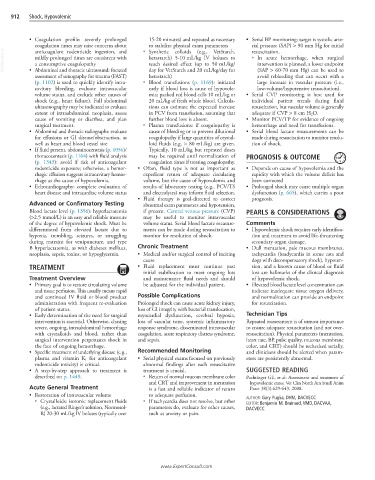Page 1823 - Cote clinical veterinary advisor dogs and cats 4th
P. 1823
912 Shock, Hypovolemic
• Coagulation profile: severely prolonged 15-20 minutes) and repeated as necessary • Serial BP monitoring: target is systolic arte-
to stabilize physical exam parameters
coagulation times may raise concerns about ○ Synthetic colloids (e.g., VetStarch, rial pressure (SAP) > 90 mm Hg for initial
VetBooks.ir mildly prolonged times are consistent with hetastarch) 5-10 mL/kg IV boluses to ○ In acute hemorrhage, when surgical
anticoagulant rodenticide ingestion, and
resuscitation.
intervention is planned, a lower endpoint
a consumptive coagulopathy
reach desired effect (up to 50 mL/kg/
• Abdominal and thoracic ultrasound: focused
assessment of sonography for trauma (FAST) day for VetStarch and 20 mL/kg/day for (SAP > 60-70 mm Hg) can be used to
hetastarch)
avoid rebleeding that can occur with a
(p. 1102) is used to quickly identify intra- ○ Blood transfusions (p. 1169): initiated large increase in vascular pressure (i.e.,
cavitary bleeding, evaluate intravascular early if blood loss is cause of hypovole- low-volume/hypotensive resuscitation).
volume status, and exclude other causes of mia; packed red blood cells 10 mL/kg or • Serial CVP monitoring is best used for
shock (e.g., heart failure). Full abdominal 20 mL/kg of fresh whole blood. Calcula- individual patient trends during fluid
ultrasonography may be indicated to evaluate tions can estimate the expected increase resuscitation, but vascular volume is generally
extent of intraabdominal neoplasia, assess in PCV from transfusion, assuming that adequate if CVP > 8 cm H 2 O.
cause of vomiting or diarrhea, and plan further blood loss is absent. • Monitor PCV/TP for evidence of ongoing
surgical treatment. ○ Plasma transfusions: if coagulopathy is hemorrhage and need for transfusions.
• Abdominal and thoracic radiographs: evaluate cause of bleeding or to prevent dilutional • Serial blood lactate measurements can be
for effusions or GI disease/obstruction, as coagulopathy if large quantities of crystal- made during resuscitation to monitor resolu-
well as heart and blood vessel size loid fluids (e.g. > 80 mL/kg) are given. tion of shock.
• If fluid present, abdominocentesis (p. 1056)/ Typically, 10 mL/kg but repeated doses
thoracocentesis (p. 1164) with fluid analysis may be required until normalization of PROGNOSIS & OUTCOME
(p. 1343): avoid if risk of anticoagulant coagulation times if treating coagulopathy.
rodenticide exposure; otherwise, a hemor- • Often, fluid type is not as important as • Depends on cause of hypovolemia and the
rhagic effusion suggests intracavitary hemor- expedient return of adequate circulating rapidity with which the volume deficit has
rhage as the cause of hypovolemia. volume, but the cause of hypovolemia and been corrected
• Echocardiography: complete evaluation of results of laboratory testing (e.g., PCV/TS • Prolonged shock may cause multiple organ
heart disease and intracardiac volume status and electrolytes) may inform fluid selection. dysfunction (p. 665), which carries a poor
• Fluid therapy is goal-directed to correct prognosis.
Advanced or Confirmatory Testing abnormal exam parameters and hypotension,
Blood lactate level (p. 1356): hyperlactatemia if present. Central venous pressure (CVP) PEARLS & CONSIDERATIONS
(>2.5 mmol/L) is an easy and reliable measure may be useful to monitor intravascular
of the degree of hypovolemic shock. Must be volume status. Serial blood lactate measure- Comments
differentiated from elevated lactate due to ments can be made during resuscitation to • Hypovolemic shock requires early identifica-
hypoxia, trembling, seizures, or struggling monitor for resolution of shock. tion and treatment to avoid life-threatening
during restraint for venipuncture, and type secondary organ damage.
B hyperlactatemia, as with diabetes mellitus, Chronic Treatment • Dull mentation, pale mucous membranes,
neoplasia, sepsis, toxins, or hypoglycemia. • Medical and/or surgical control of inciting tachycardia (bradycardia in some cats and
cause dogs with decompensatory shock), hypoten-
TREATMENT • Fluid replacement must continue past sion, and a known cause of blood or fluid
initial stabilization to meet ongoing loss loss are hallmarks of the clinical diagnosis
Treatment Overview and maintenance fluid needs and should of hypovolemic shock.
• Primary goal is to restore circulating volume be adjusted for the individual patient. • Elevated blood lactate level concentration can
and tissue perfusion. This usually means rapid indicate inadequate tissue oxygen delivery,
and continued IV fluid or blood product Possible Complications and normalization can provide an endpoint
administration with frequent re-evaluation Prolonged shock can cause acute kidney injury, for resuscitation.
of patient status. loss of GI integrity with bacterial translocation,
• Early determination of the need for surgical myocardial dysfunction, cerebral hypoxia, Technician Tips
intervention is essential. Otherwise, chasing loss of vascular tone, systemic inflammatory Repeated reassessment is of utmost importance
severe, ongoing, intraabdominal hemorrhage response syndrome, disseminated intravascular to ensure adequate resuscitation (and not over-
with crystalloids and blood, rather than coagulation, acute respiratory distress syndrome, resuscitation). Physical parameters (mentation,
surgical intervention perpetuates shock in and sepsis. heart rate, BP, pulse quality, mucous membrane
the face of ongoing hemorrhage. color, and CRT) should be rechecked serially,
• Specific treatment of underlying disease (e.g., Recommended Monitoring and clinicians should be alerted when param-
plasma and vitamin K 1 for anticoagulant • Serial physical exams focused on previously eters are persistently abnormal.
rodenticide toxicity) is critical. abnormal findings after each resuscitative
• A step-by-step approach to treatment is treatment is crucial. SUGGESTED READING
described on p. 1449. ○ Return of normal mucous membrane color Pachtinger GE, et al: Assessment and treatment of
and CRT and improvement in mentation hypovolemic states. Vet Clin North Am Small Anim
Acute General Treatment is a fast and reliable indicator of return Pract 38(3):629-643, 2008.
• Restoration of intravascular volume to adequate perfusion.
○ Crystalloids: isotonic replacement fluids ○ If tachycardia does not resolve, but other AUTHOR: Gary Puglia, DVM, DACVECC
EDITOR: Benjamin M. Brainard, VMD, DACVAA,
(e.g., lactated Ringer’s solution, Normosol- parameters do, evaluate for other causes, DACVECC
R) 20-30 mL/kg IV boluses (typically over such as anxiety or pain.
www.ExpertConsult.com

